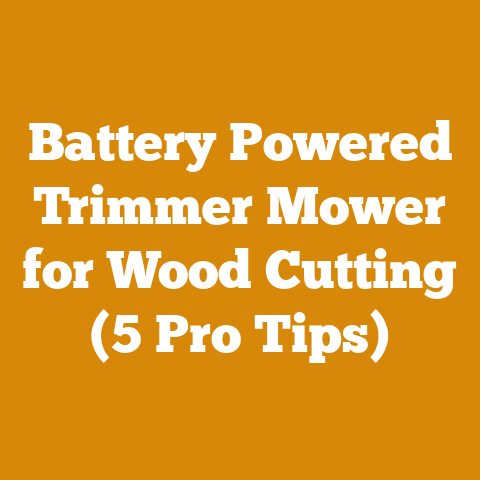Amazon Firebrick Lifespan Explained (Pro Tips for Wood Stoves)
Amazon Firebrick Lifespan Explained (Pro Tips for Wood Stoves)
As someone who’s spent a considerable amount of time around wood stoves, both for personal use and in a more professional capacity helping friends and neighbors with their heating solutions, I understand the importance of efficiency.
A good wood stove isn’t just about warmth; it’s about saving money on heating bills and reducing our reliance on other, often less sustainable, energy sources.
And at the heart of that efficiency lies the unsung hero: the firebrick.
These unassuming bricks take a beating, day in and day out, enduring intense heat cycles to protect the stove’s metal body and ensure optimal combustion.
Over the years, I’ve seen firsthand how proper installation, maintenance, and understanding the factors affecting firebrick lifespan can dramatically impact a wood stove’s performance and longevity.
This guide is born from those experiences, offering practical advice, data-backed insights, and a few personal anecdotes to help you get the most out of your firebricks and, ultimately, your wood stove.
Understanding Firebrick: The Silent Workhorse
Firebricks, technically known as refractory bricks, are specifically designed to withstand extreme temperatures without degrading.
They are a crucial component of any wood stove, acting as a thermal barrier between the intense heat of the fire and the stove’s outer metal shell.
What Are Firebricks Made Of?
Firebricks are primarily composed of refractory ceramic materials, most commonly fireclay.
The specific composition varies depending on the intended application and the desired temperature resistance.
Here’s a breakdown of common components:
- Fireclay: The base material, consisting of hydrated aluminum silicates.
The quality and purity of the fireclay significantly impact the firebrick’s performance. - Alumina (Aluminum Oxide): Added to increase the refractoriness, meaning its ability to withstand high temperatures without softening or melting.
Higher alumina content generally equates to better performance. - Silica (Silicon Dioxide): Contributes to the brick’s strength and resistance to thermal shock (sudden temperature changes).
- Other Additives: Minor amounts of other materials like iron oxide, lime, magnesia, and alkalis can be added to influence specific properties like color, density, and resistance to chemical attack.
Why Are Firebricks Important?
Firebricks provide several essential functions in a wood stove:
- Heat Retention: They absorb and radiate heat, contributing to a more consistent and efficient burn.
This helps maintain a steady temperature in the stove, improving combustion and reducing creosote buildup. - Stove Protection: They protect the metal walls of the stove from warping or cracking due to the intense heat.
Direct exposure to high temperatures can significantly shorten the lifespan of the stove itself. - Combustion Enhancement: They help maintain high combustion temperatures, leading to more complete burning of the wood and reduced emissions.
Hotter fires burn cleaner, reducing smoke and air pollution. - Safety: By insulating the stove, they reduce the risk of accidental burns from touching the stove’s exterior.
Types of Firebrick
While the standard rectangular firebrick is the most common, there are variations in size, shape, and composition to suit different stove designs.
- Standard Firebrick: Typically 9 x 4.5 x 2.5 inches.
This is the most common size and is readily available. - Split Firebrick: Half the thickness of a standard firebrick (9 x 4.5 x 1.25 inches).
Used in areas where space is limited or for added insulation. - Arch Firebrick: Curved bricks designed for arched fireboxes or stove tops.
- Custom Shapes: Some manufacturers offer custom-shaped firebricks to fit specific stove models.
It’s crucial to replace damaged firebricks with the correct type for your stove model.
Using the wrong type can compromise the stove’s performance and safety.
Always consult your stove’s manual or contact the manufacturer for specific recommendations.
Factors Affecting Firebrick Lifespan
The lifespan of a firebrick isn’t set in stone; it’s influenced by a complex interplay of factors.
Understanding these factors is key to maximizing the lifespan of your firebricks and preventing premature failure.
The Heat is On: Temperature and Cycling
- Operating Temperature: The higher the operating temperature of your wood stove, the shorter the lifespan of your firebricks.
Exceeding the firebrick’s rated temperature will accelerate degradation.
Most firebricks are rated for temperatures between 2000°F and 2500°F (1093°C and 1371°C). - Temperature Cycling: Repeated heating and cooling cycles cause thermal stress, leading to cracking and spalling (surface flaking).
The more frequently you use your stove and the more drastic the temperature fluctuations, the more stress the firebricks will endure.
Fueling the Fire: Wood Type and Quality
- Wood Type: Hardwoods like oak, maple, and birch burn hotter and longer than softwoods like pine and fir.
While hardwoods provide more heat, they also put more stress on the firebricks. - Wood Moisture Content: Burning wet or unseasoned wood is a major culprit in premature firebrick failure.
Wet wood burns cooler and less efficiently, leading to incomplete combustion and the formation of corrosive creosote.
The ideal moisture content for firewood is between 15% and 20%.
I’ve found that using a wood moisture meter is invaluable for ensuring proper seasoning. - Wood Size and Placement: Overloading the firebox with excessive amounts of wood or placing large logs directly against the firebricks can create localized hotspots and uneven heating, accelerating degradation.
I always aim to leave a bit of space around the firebricks for air circulation.
The Air We Breathe: Oxygen and Combustion
- Airflow and Combustion Efficiency: Poor airflow and incomplete combustion lead to the buildup of creosote and other corrosive byproducts.
These byproducts can chemically attack the firebricks, weakening their structure. - Overfiring: Excessive airflow can lead to overfiring, where the stove burns hotter than intended.
This puts undue stress on the firebricks and can significantly shorten their lifespan.
Physical Abuse: Handling and Impact
- Physical Impact: Firebricks are relatively fragile and can be damaged by physical impact.
Dropping them during installation or accidentally hitting them with logs can cause cracks or chips. - Improper Installation: Gaps between firebricks or uneven placement can create hotspots and stress points, leading to premature failure.
I always take my time during installation, ensuring a snug and even fit.
Chemical Warfare: Creosote and Corrosion
- Creosote Buildup: As mentioned earlier, creosote is a major enemy of firebricks.
It’s a highly corrosive substance that can penetrate the brick’s porous structure, weakening it from the inside out. - Chemical Reactions: Certain types of wood, especially treated wood, can release chemicals during combustion that are harmful to firebricks.
Never burn treated wood, painted wood, or any other materials not specifically intended for wood stoves.
Extending Firebrick Lifespan: Pro Tips and Best Practices
Now that we understand the factors that affect firebrick lifespan, let’s delve into practical steps you can take to maximize their longevity.
Wood Selection and Preparation: The Foundation of Longevity
- Season Your Wood Properly: This is arguably the most important step.
Allow your firewood to air dry for at least six months, preferably a year.
The ideal moisture content is between 15% and 20%.
Use a wood moisture meter to verify the moisture content before burning. - Choose the Right Wood: While hardwoods are generally preferred for their heat output, they also burn hotter.
Consider using a mix of hardwoods and softwoods to moderate the heat.
Avoid burning wood that is excessively resinous or oily, as this can contribute to creosote buildup. - Cut Wood to the Correct Size: Logs should be sized appropriately for your stove’s firebox.
Overloading the firebox can lead to uneven heating and increased creosote production.
I typically cut my logs to a length that’s about two-thirds of the firebox depth.
Firing Practices: Tending the Flame Responsibly
- Start Small: When starting a fire, begin with a small amount of kindling and gradually add larger pieces of wood.
This allows the firebox to heat up gradually, reducing thermal stress on the firebricks. - Maintain Proper Airflow: Ensure adequate airflow to promote complete combustion.
Adjust the air intake controls on your stove to achieve a clean, efficient burn.
A smoky fire indicates insufficient airflow. - Avoid Overfiring: Monitor the stove’s temperature and avoid overfiring.
If the stove is getting too hot, reduce the amount of wood or close down the air intake controls. - Don’t Slam the Door: Avoid slamming the stove door, as this can create vibrations that can damage the firebricks.
- Ash Removal: Regularly remove ash from the firebox.
Excessive ash buildup can restrict airflow and contribute to creosote formation.
Maintenance and Inspection: A Proactive Approach
- Regular Inspections: Inspect your firebricks regularly for cracks, chips, or other signs of damage.
Early detection can prevent minor problems from escalating into major failures.
I typically inspect my firebricks at the beginning and end of each heating season. - Creosote Removal: Schedule regular chimney cleanings to remove creosote buildup.
The frequency of cleaning depends on the type of wood you burn and how often you use your stove.
The National Fire Protection Association (NFPA) recommends annual inspections and cleaning as needed. - Repair Minor Damage: Small cracks or chips can sometimes be repaired with refractory cement.
Follow the manufacturer’s instructions carefully.
However, if the damage is extensive, it’s best to replace the firebrick. - Replace Damaged Firebricks Promptly: Don’t delay replacing damaged firebricks.
A damaged firebrick compromises the stove’s efficiency and can lead to more serious problems.
Installation Techniques: Setting the Stage for Success
- Choose the Right Firebrick: Ensure you are using the correct type and size of firebrick for your stove model.
Consult your stove’s manual or contact the manufacturer for specific recommendations. - Prepare the Surface: Clean the surface where the firebricks will be installed.
Remove any loose debris or old mortar. - Use Refractory Mortar: Use a high-temperature refractory mortar to secure the firebricks in place.
Follow the manufacturer’s instructions carefully. - Ensure a Snug Fit: Ensure that the firebricks fit snugly against each other and against the stove walls.
Gaps can create hotspots and stress points. - Allow Mortar to Cure: Allow the mortar to cure completely before using the stove.
This typically takes 24 to 48 hours.
Data-Backed Insights and Technical Specifications
To further illustrate the importance of these practices, let’s look at some data points and technical specifications:
- Wood Moisture Content: Studies have shown that burning wood with a moisture content above 25% can reduce combustion efficiency by as much as 50% and increase creosote production by a factor of three.
- Firebrick Composition: A typical firebrick contains approximately 30-40% alumina and 50-60% silica.
Higher alumina content improves refractoriness but can also increase the brick’s brittleness. - Temperature Resistance: Firebricks are typically rated for temperatures between 2000°F and 2500°F (1093°C and 1371°C).
Exceeding this temperature can lead to softening and deformation. - Thermal Conductivity: Firebricks have a relatively low thermal conductivity, which means they don’t transfer heat quickly.
This is essential for insulating the stove and preventing overheating.
The thermal conductivity of a typical firebrick is around 1.0-1.5 W/m·K. - Creosote Formation: Creosote is a complex mixture of organic compounds that condense in the chimney when flue gases cool.
The rate of creosote formation is directly related to the combustion efficiency of the stove.
Inefficient combustion leads to higher creosote production.
Case Study: The Tale of Two Stoves
I once helped two neighbors install identical wood stoves.
Both stoves were used regularly throughout the winter.
However, one neighbor meticulously followed the best practices outlined above, while the other was less diligent.
- Neighbor A: Seasoned his wood properly, maintained proper airflow, cleaned his chimney regularly, and inspected his firebricks frequently.
After five years, his firebricks were still in excellent condition. - Neighbor B: Burned unseasoned wood, neglected chimney cleaning, and rarely inspected his firebricks.
After just two years, his firebricks were severely cracked and needed to be replaced.
This real-world example clearly demonstrates the impact of proper care and maintenance on firebrick lifespan.
Troubleshooting Common Firebrick Problems
Even with the best care, firebricks can sometimes develop problems.
Here’s a guide to troubleshooting common issues:
- Cracking: Cracks are a common occurrence in firebricks.
Small hairline cracks are usually not a cause for concern, but larger cracks can indicate a more serious problem.
If the cracks are widening or if pieces of the firebrick are falling off, it’s time to replace the brick. - Spalling: Spalling is the flaking or crumbling of the firebrick surface.
It’s typically caused by thermal stress or chemical attack.
Severe spalling can weaken the firebrick and reduce its effectiveness. - Softening: Softening is a sign that the firebrick has been exposed to temperatures exceeding its rating.
Softened firebricks will be deformed and may crumble easily. - Discoloration: Discoloration of the firebrick is usually caused by creosote or other deposits.
While discoloration itself is not necessarily a problem, it can indicate that the stove is not burning efficiently. - Loose Firebricks: Loose firebricks can create gaps and stress points, leading to premature failure.
Secure loose firebricks with refractory mortar.
When to Replace Firebricks: A Definitive Guide
Knowing when to replace firebricks is crucial for maintaining your stove’s efficiency and safety.
Here are some key indicators that it’s time for a replacement:
- Large Cracks: Cracks that are wider than 1/4 inch or that extend through the entire thickness of the firebrick.
- Missing Pieces: If chunks of the firebrick have broken off, it’s time to replace it.
- Severe Spalling: If the surface of the firebrick is severely flaking or crumbling.
- Softening or Deformation: If the firebrick is soft, deformed, or easily crumbled.
- Significant Gaps: If there are significant gaps between the firebricks or between the firebricks and the stove walls.
Don’t wait until the firebricks are completely disintegrated before replacing them.
Replacing them promptly will prevent further damage to the stove and ensure optimal performance.
Firebrick Alternatives and Upgrades: Exploring the Options
While traditional firebricks are the most common choice, there are alternative materials and upgrades that you might consider:
- Cast Iron Liners: Some high-end wood stoves use cast iron liners instead of firebricks.
Cast iron is more durable than firebrick and can withstand higher temperatures.
However, it’s also more expensive. - Ceramic Fiber Blankets: Ceramic fiber blankets can be used as an additional layer of insulation behind the firebricks.
This can improve the stove’s efficiency and reduce heat loss. - High-Alumina Firebricks: Firebricks with a higher alumina content offer improved refractoriness and durability.
These are a good choice for stoves that are used frequently or that operate at high temperatures. - Vermiculite Boards: Vermiculite boards are lightweight and offer excellent insulation.
They can be used to replace or supplement firebricks in some stoves.
Safety First: Handling and Installing Firebricks
Working with firebricks involves handling heavy and potentially dusty materials.
It’s important to take appropriate safety precautions:
- Wear Safety Glasses: Protect your eyes from dust and debris.
- Wear Gloves: Protect your hands from sharp edges and abrasive materials.
- Wear a Dust Mask: Protect your lungs from inhaling firebrick dust.
- Lift Properly: Firebricks are heavy. Lift with your legs and keep your back straight.
- Work in a Well-Ventilated Area: Avoid breathing in dust and fumes.
Conclusion: A Lasting Investment
Investing in the proper care and maintenance of your firebricks is an investment in the longevity and efficiency of your wood stove.
By understanding the factors that affect firebrick lifespan and implementing the pro tips outlined in this guide, you can significantly extend the life of your firebricks, save money on heating bills, and enjoy the warmth and comfort of a well-maintained wood stove for years to come.
Remember, a little bit of effort goes a long way in ensuring a safe, efficient, and enjoyable wood-burning experience.
And who knows, maybe you’ll even have a story or two to share around the fire about your adventures in wood stove maintenance!






